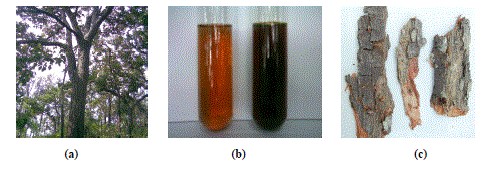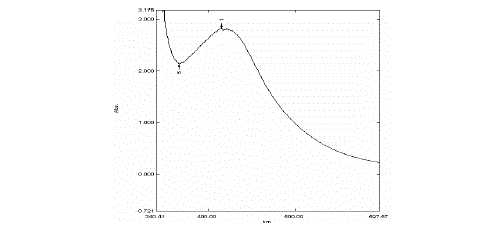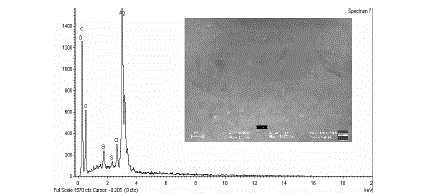INTRODUCTION
|
| |
| Nanoparticles are usually referred to as particles with a maximum size of 100 nm. Nanoparticles exhibit completely new or improved properties compared to larger particles of the bulk material and these novel properties are derived due to the variation in specific characteristics such as size, distribution and morphology of the particles. Nanoparticles present a higher surface area-to volume ratio with decrease in the size of the particles. Specific surface area is relevant for catalytic activity and other related properties such as antimicrobial activity of AgNPs1,2,3.As the specific surface area of nanoparticles is increased, their biological effectiveness can also increase on the account of a rise in surface energy. Nanoparticles have a wide range of applications, as in combating microbes 4, biolabelling 5, and in the treatment of cancer 6. Therefore, there is a growing need to develop environmentally friendly processes for nanoparticle synthesis without using toxic chemicals. Biological methods for nanoparticle synthesis using microorganisms, enzymes, and plants or plant extracts have been suggested as possible ecofriendly alternatives to chemical and physical methods 7. There have been recent reports on phytosynthesis of silver and gold nanoparticles by employing coriander leaves 8, sundried Cinnamomum camphora leaves 9, phyllanthin extract 10, and purified apiin compound extracted from henna leaves 11. |
| |
| Shorea tumbuggaia Roxb. or Vatica tumbuggaia. Wt. & Arn. (Diptero carpaceae). Commonly known as: Green Dammar. It is large sporadic resinous tree attains the maximum height of about 20-30m with maximum width of 150-190 cm. Bark is thick, rough dark brown longitudinally furrowed, within the furrows gum is exuded. Simple leaves with ultimate reticulate venation. Inflorescence is Axillary/ terminal panicles 12. Flowers white. Fruits with a woody pericarp with wings 2-3 times as long as capsule 13. S.tumbuggaia is a tree taxa with economic and medicinal values. Stem is used in marine yards as a substitute for pitch. The tree trunk is in use as flag poles for temples. The heart wood is similar to sal but much smoother and better for carpentry. The plant extracts used to cure ear-aches, external stimulant. Leaf juice is used as ear drops for children. The bark having anti ulcer activity 14. The stem is a source of resin, which is use as incense. The Resin used to cure duodenal ulcers and Amoebic dysentery. It is also used in indigenous medicine as an external stimulant and a substitute for Abietis; Resina and Pix Burgundica of European pharmacopoeias. Although this plant is considered as undesirable plant, but to the best of our knowledge we are the first to report its use in synthesizing silver nanoparticles, which can provide a new platform to this plant making it a value added tree for nanotechnology based medicine in future. |
| |
MATERIAL AND METHODS
|
| |
|
Plant material and Synthesis of silver nanoparticles
|
| |
| Shorea tumbuggaia stem barks were collected from Tirumala hills, Andhra pradesh state, India. The stem bark were air dried for 10 days then bark were kept in the hot air oven at 60°c for 24-48 hrs. The barks were ground to a fine powder. 1 mM silver nitrate was added to plant extract to make up a final solution 200 ml and centrifuged at 18.000 rpm for 25 min.The collected pellet stored at -4°c.The supernatant was heated at 50°c to 95°c.A change in the color of solution was observed during the heating process. |
| |
|
UV-VIS Spectra analysis
|
| |
| The reduction of pure Ag+ ions was monitored by measuring the UV-Vis spectrum of the reaction medium at 5 hours after diluting a small aliquot of the sample into distilled water. UV-Vis spectral analysis was done by using UV-VIS spectrophotometer UV- 2450 (Shimadzu). |
| |
|
SEM analysis of silver nanoparticles
|
| |
| Scanning Electron Microscopic (SEM) analysis was done using Hitachi S-4500 SEM machine. Thin films of the sample were prepared on a carbon coated copper grid by just dropping a very small amount of the sample on the grid, extra solution was removed using a blotting paper and then the film on the SEM grid were allowed to dry by putting it under a mercury lamp for 5 min. |
| |
|
EDAX measurements
|
| |
| In order to carry out EDAX analysis, the bark extracts reduced silver nanoparticles were dried and drop coated on to carbon film and performed on Hitachi S-3400 N SEM instrument equipped with a Thermo EDAX attachments. |
| |
RESULT AND DISCUSSION
|
| |
| Reduction of silver ion into silver particles during exposure to the plant extracts could be followed by color change. Silver nanoparticle exhibit dark yellowish – brown color in aqueous solution due to the surface Plasmon resonance phenomenon (Fig.1). The result obtained in this investigation is very interesting in terms of identification of potential forest plant for synthesizing the silver nanoparticles. UV-Vis spectrograph of the colloidal solution of silver nanoparticles has been recorded as a function of time. Absorption spectra of silver nanoparticles formed in the reaction media at 10 min. has absorbance peak at 430 nm and the broadening of peak indicated that the particles are polydispersed (Fig.2). From EDAX spectrum, it is clear that Shorea tumbuggaia has recorded weight percent (33.52 %) of silver nanoparticle. The SEM image showed relatively spherical shape nanoparticle formed with diameter range 40 nm (Fig.3). Similar phenomenon was reported by Chandran et al.15 |
| |
CONCLUSION
|
| |
| The bio-reduction of aqueous Ag+ ions by the stem bark extract of the plant Shorea tumbuggaia has been demonstrated. The reduction of the metal ions through bark extracts leading to the formation of silver nanoparticles of fairly well-defined dimensions. This green chemistry approach toward the synthesis of silver nanoparticles has many advantages such as, ease with which the process can be scaled up, economic viability, etc. Applications of such eco-friendly nanoparticles in bactericidal, wound healing and other medical and electronic applications, makes this method potentially exciting for the large-scale synthesis of other inorganic materials (nanomaterials). The antimicrobial studies of Shorea tumbuggaia mediated synthesized silver nanoparticles are under investigation. |
| |
Conflict of Interest
|
| |
| NIL |
| |
Source of Support
|
| |
| NONE |
| |
Figures at a glance
|
 |
 |
 |
| Figure 1 |
Figure 2 |
Figure 3 |
|
| |
| |
| |









